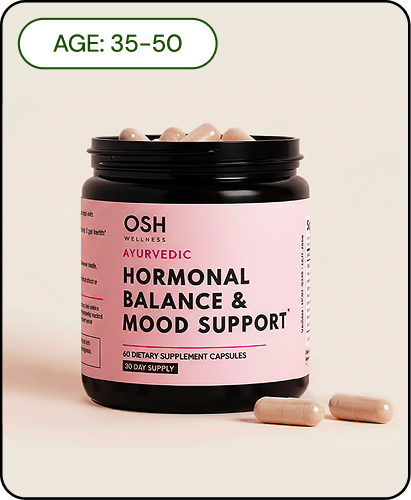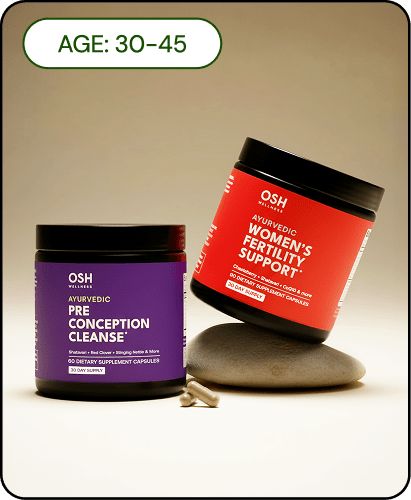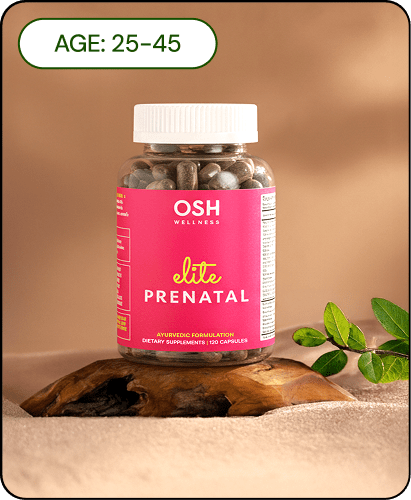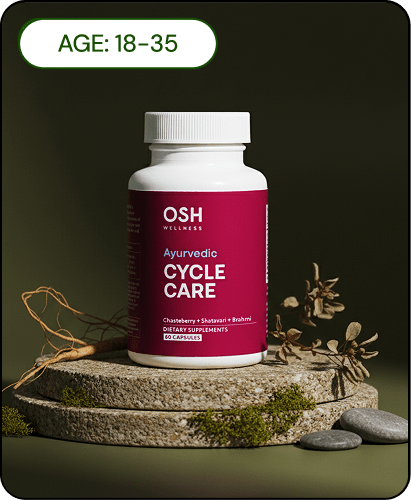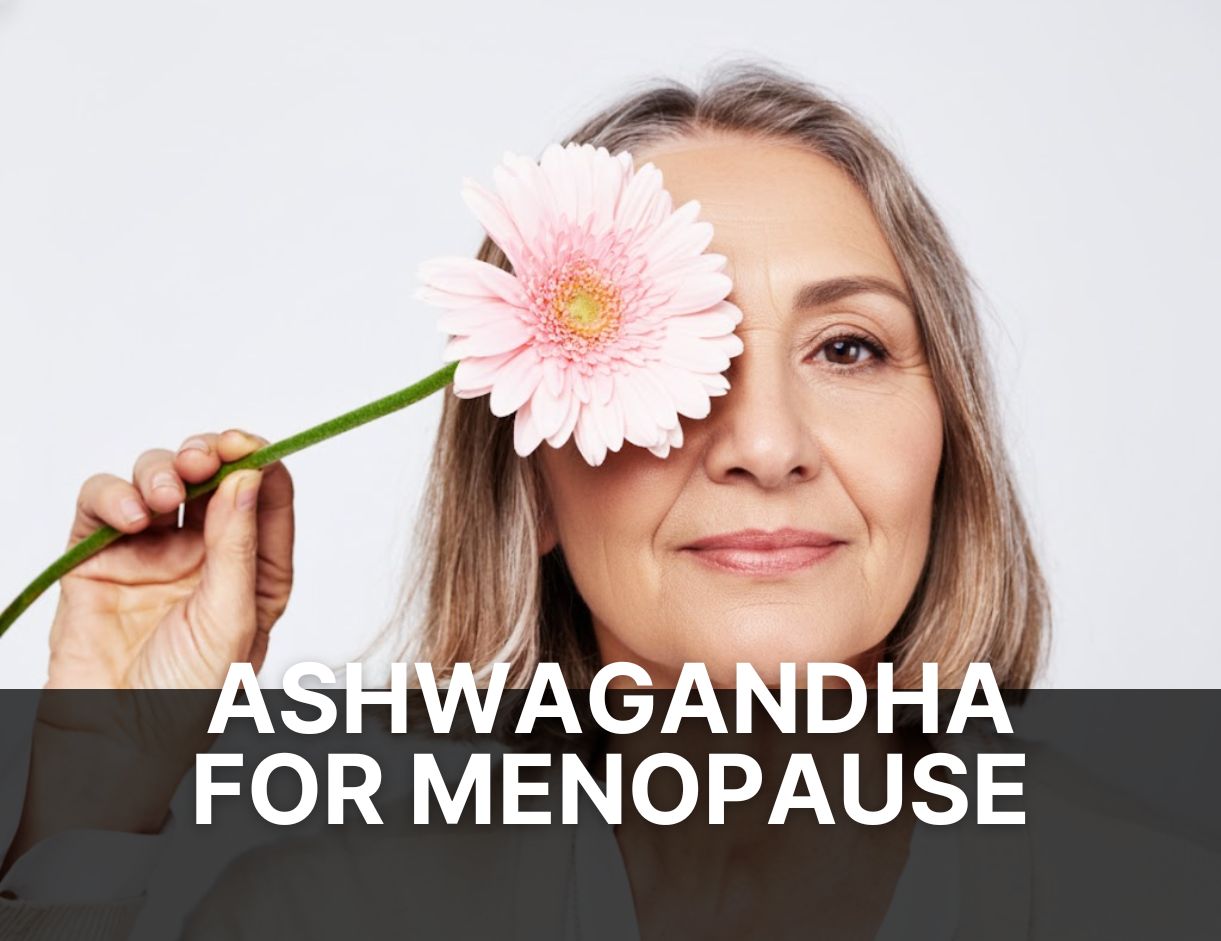Table of contents
With rates of cognitive decline, from Alzheimer’s Disease, dementia, as well as related conditions like Parkinson's, increasing among younger populations, and the draining of our attention banks from non-stop technology and social media use, brain health is top-of-mind (pun intended!) for everyone these days. It’s tempting to jump on the pathologizing train at the first sign of forgetfulness or brain fog; early diagnoses can be key in slowing the progression of real diseases, but we might also do well to pause and assess the true cause, called nidana in Ayurvedic medicine, of any imbalance, cognitive or otherwise, so we can find the most effective solution. Including determining whether what we are experiencing is even a “disorder” at all, or part of a natural life transition that can be supported rather than “cured.”
What is Menopausal Brain Fog?

Brain fog, forgetfulness, and mood changes that creep in (or show up suddenly at the door with enough bags for a few years’ stay) during a woman’s late thirties and forties are a classic example of an imbalance that isn't genuine “disease.” In most cases, this shift in our body-brain chemistry is part of the natural transition of perimenopause, when a woman moves toward the cessation of her menstrual cycles.
Depending on the person, perimenopause (and associated symptoms) can last up to 10 years before a woman stops bleeding; for others, the transition is more like one month “on,” the next month “off,” and that’s that. Menopause is defined by a lack of menstrual cycles (bleeding) for a full year (12 months).
In either case, Ayurveda describes the system-wide changes as a factor of kala, or time, which changes the treatment approach. In other situations, there are deviations from a person’s “normal,” or prakrti, and interventions are meant to bring them back to that unique baseline. When Kala is involved, however, we are actually establishing a new baseline. In the case of menopause, the organism is moving from the broad life stage defined by pitta dosha, which is made of the fire and water elements and characterized by activity and transformation, to a life stage defined by vata dosha, which is made of air and space elements and characterized by subtlety and lightness.
A person’s core identity won’t necessarily change in this transition, but the way they express that self, their capacity to engage in the world, and their goals and priorities might change.
In a certain way, menopause is almost identical to the changes we undergo in puberty, another significant shift from a world of play and innocence (kapha dosha) to one of goals and responsibility (pitta), but in reverse.
Indeed, remembering (if we can) the state of our hormone-possessed teenage mind is a helpful tool in understanding and working with what happens during menopause. While teenagers have a bad rap for being moody, not paying attention, doing dumb stuff, and needing to sleep and eat all the time, these traits aren’t really their fault (at least, not entirely their fault). When reproductive hormones start surging, the chemical makeup of the body and brain shifts dramatically, requiring huge amounts of energy and integration time for growth. Hormones in general are considered a kind of agni, or fire, in Ayurveda, and we see that conflagration in the insatiable appetites, fits of passion, intense emotions, and angry skin that teens are known for. The brain itself is also undergoing a structural makeover, weeding out unnecessary memories and creating new pathways for habits and skills. While teens look more like adults on the outside, their prefrontal cortexes (the area of the brain responsible for executive function and discernment) aren’t fully baked, so they’re more driven by impulse than logic (hence the illogical decisions and classic “what were you thinking???” parental response. Answer: they weren’t thinking).
Estrogen’s Mic Drop
On the flip side of this transition, menopause reverses the hormonal balance that peaked at puberty and remained relatively stable in our twenties and thirties, causing a shift in rhythms that once allowed us to be present and productive in the material world.
Around age thirty-five, a woman’s natural estrogen stores rapidly decline, followed by a pronounced decrease in progesterone closer to menopause itself.
These two major female reproductive hormones act in a beautiful partnership during the years of menstruation: estrogen helps to nourish and mature egg cells that are released at ovulation with a surge of progesterone, which then helps to maintain the uterine lining for possible implantation. Progesterone evens out the intensity of emotions that estrogen is known for inducing; hence, when it drops off toward the end of the cycle before bleeding, those emotions might surge again as “PMS.”
Besides its reproductive functions, however, estrogen is involved in several physiological checks and balances that all ebb and flow with the cycle (and, naturally, shift in menopause): thermoregulation, circadian rhythms (including sleep and metabolism/blood sugar regulation), and sensory perception are among some of the most important.
During perimenopause, the decreased amount of circulating estrogen in the system will produce less predictable ovulation, meaning that progesterone won’t be around reliably to “check” the estrogen that is there. When there is more relative estrogen compared to progesterone, it’s known as an “estrogen dominance,” which can also occur outside of menopause for other reasons. When this happens naturally, though, periods can become irregular and heavy, and there’s more moodiness, but there won’t necessarily be hot flashes.
Shifts in these ovulation patterns can be hard to pin down, especially in our world, where vata, in the form of intense, erratic movement, increased mental stimulation, and overall stress, dominates. A woman in her mid- to late-thirties might notice changes to ovulation from (early) perimenopause, or it might simply be a function of stress and lack of nourishment, and routine in her life. This can happen because the body, in its deep wisdom and desire to stay alive, will prioritize stress hormones like cortisol and adrenaline over reproductive hormones (you can’t make babies if you’re dead).
When stress is high and/or chronic, the adrenals that make stress hormones might become depleted and draw on other resources to maintain the state of the sympathetic nervous system; progesterone can be converted to cortisol in a process known as the “cortisol steal” (or, as Dr. Claudia Welch calls it, “the bucket syndrome”).
Without enough progesterone, ovulation won’t happen, and estrogen dominance can result (even relatively, as in, not excess estrogen in an absolute sense but more relative to progesterone); you may still bleed, but the periods might be irregular, and fertility will be impacted. Hormonal birth control will also stop ovulation (on purpose) by artificially manipulating hormone levels; when a woman stops these pharmaceuticals, as is happening more often when women in their thirties decide to try to get pregnant, natural periods and ovulation cycles might not return immediately, as the body remembers how and when to initiate the hormonal cascade.
Suppose the cortisol steal is happening pretty regularly in one’s thirties. In that case, you might imagine what would happen once a woman enters the perimenopausal window: progesterone is already depleted, so the further shift in the estrogen/progesterone balance will exacerbate the transitional irregularities, raising vata as both a force of instability and through general depletion.
This is Your Brain Off Estrogen

When it comes to the brain itself, estrogen (and its absence) again contributes to our state of not feeling like ourselves anymore. Its role in sleep and metabolic rhythms will strongly affect the state of the microbiome, which in turn affects signals being sent via the gut-brain axis to the nervous system and subsequent hormone and neurotransmitter production. Anyone who’s been sleep deprived for any reason knows how foggy the world seems when you’re not rested, and so menopausal sleep disturbances (usually due to hot flashes or waking between 1 and 3 am) will directly affect cognition. Likewise, higher estrogen (including relative to progesterone) will contribute to inflammation and elevated blood glucose, a state similar to the stress response in general. And with uneven blood sugar, the body’s energy reserves and stamina will be affected.
The estrogen-glucose relationship also plays a role in how the brain literally changes in menopause. During the early years, the estrogen receptor network is decoupled from the bioenergetic system.
Since women’s brains have more estrogen receptors than men do for testosterone, women generally make more connections/communications overall during the pitta stage of life when estrogen is replete and flowing freely month to month.
At menopause, the drop in estrogen naturally means those connections decrease in quality and quantity, resulting in slower/duller thinking, reduced memory, and a generally compromised ability to communicate and self-regulate.
At the same time, the brain needs to find a new fuel source when estrogen drops off. The brain normally runs on glucose, and the tanks stay full when all those estrogen receptors are online. When estrogen plummets, so does the fuel, and the brain gets hangry. Thankfully, this aspect of the transition is only temporary and will resolve once the brain shifts over to using ketones for fuel instead of glucose (which is one reason why a lower-carb diet can be useful in all cases of cognitive decline and attention deficit, including the “natural” declines due to age without a true pathology).
The brain’s white matter and glucose metabolism decrease and stay low through the vata stage of life, benefitting from dietary shifts described below, but the reasons for short-term brain fog, decreased cerebral blood flow, and gray matter aren’t long-lasting. It also helps explain why memory issues will start long before any changes to menstruation.
Research on the efficacy of hormone replacement therapy on menopausal cognitive changes is mixed. But, when we consider the role of the cortisol steal/vata leading up to menopause, we do see a big connection. For women with balanced estrogen levels (less affected by stress), the blood sugar shifts are less pronounced or not even present, so the swing of menopause might feel less dramatic.
Ayurvedic Herbal Remedies for Menopausal Brain Health

Just because Ayurveda doesn’t consider menopause to be a “disease” per se, it doesn’t mean we just let vata take over and strap in for a decade-long roller coaster ride of emotions, fatigue, and confusion. Our interventions help to smooth out and assist the natural ebb of estrogen, so we land on the other shore of menopause having floated down a gentle lazy river (plenty of juiciness!) rather than having jumped off a cliff. Generally speaking, the approach is all about managing vata, though pitta and kapha also contribute to different symptom patterns.
When estrogen begins its early decline and the brain begins its fuel shift, we want to stabilize metabolism/agni. During this transition and after, the body and brain will need to be able to digest and absorb denser (brmhana) sources of nutrition (aka a vata-balancing diet, full of foods that are warm, heavy, and oily) to counteract the general dominance of vata, and to help maintain cholesterol which is required for all adrenal hormone production (even after menopause, when the ovaries shut down estrogen production, the adrenals sill produce a small amount; this is also where men produce small amounts of estrogen for non-reproductive function). But before you adopt a more brmhana diet, you must have adequate agni to prevent it from becoming metabolic waste.
A moderate approach includes:
Eating 2-4 meals a day at regular intervals, eating until you are satiated, so you don’t need to snack in between
Leaving 12-14 hours between the last meal of the day and breakfast (err toward 12 hours if you are still menstruating)
Consuming 2-3 half-cup servings of beans and legumes a day (for fiber and easily digested protein)
Consuming animal protein per digestive capacity, especially at lunch
Minimizing caffeine and alcohol (which impact blood sugar); avoid coffee before food at breakfast, which can reduce agni overall, throw off cortisol levels, and impact sleep hormones later in the day
Cooking with ghee, a significant source of butyric acid, which feeds the gut microbiome and crosses the blood-brain barrier to support cognition and memory; also supports agni without increasing pitta (its special action, or prabhava, per Ayurveda)
When progesterone levels dip, whether from the cortisol steal or during menopause’s later stages, Ayurveda reminds us that balance can be gently restored. Herbs like Vitex (Nirgundi), the nervines nutmeg, bacopa, and rose, along with adaptogens such as Shatavari and Ashwagandha, help nurture the body back into hormonal harmony.
For general inflammation, due to blood sugar and/or poor sleep, Ayurveda has several potent anti-inflammatories that fall into the category of medhya rasayanas (rejuvenatives for the mind):
Bacopa (Bacopa monnieri)
Gotu Kola (Centella asiatica)
Shankpushpi (Convolvulus prostratus)
Ginger
Vitamin D and fish oil supplementation can also be supportive
Other herbs that can support sleep by calming anxiety and maintaining blood sugar (you wake up from sleep if it drops too low) include lavender, lemon balm, kava, and valerian; passionflower is also well-studied to support menopausal insomnia (waking between 1 and 3 am).
Self-Care for Vata
In Ayurveda, the function of the mind isn’t only located in the brain; however, the entire body is the home of the channel of the mind, or manovaha srotas, and in particular, the skin. Since touch is the sense we experience through the skin, and the sense most associated with vata (along with sound), the practice of abhyanga is an important component of any menopausal self-care routine, or whenever there are mental disturbances or irregularities.
When we gently massage oil into the skin in the morning and/or evening, we are both cleansing and nourishing this largest organ of sensory perception and digestion, helping to regulate vata from the outside in.
By maintaining a healthy skin microbiome, the body’s immune and inflammatory responses are kept in check as well. And of course, the trademark sign of vata, dryness, is soothed by the oil itself; special formulas like shatavari ghee can be employed to support vaginal dryness as a more local abhyanga.
Though it might not seem obvious, abhyanga is also a traditional response to what people are trying to achieve these days by doing heavy strength workouts and consuming high-protein diets. While these activities are technically vata-pacifying and can be done healthfully, the naturally lowered agni in the vata stage of life (and during perimenopause) can make it hard to digest this ultra-dense food (protein) needed to maintain the muscle mass for heavy lifting (or any intense exercise). Abhyanga will maintain muscle tone, circulation, and elasticity of the skin, and offer supplemental brmhana that does not need to be “digested” internally if agni is low.
By reducing vata overall, we’re also protecting the body from unnecessary bone loss that can be accelerated by stress or poor digestion/absorption of nutrition due to stress. Closely related to both vata and the nervous system, bones can be strengthened by lifting heavy things and by practicing intentional relaxation through practices like abhyanga, restorative yoga, time in nature, or other creative pursuits that make you feel like yourself.
Conclusion
No matter where you are on your menopausal journey, or if you’re accompanying a woman on hers, expecting and embracing the layers of change involved is key to preserving your sense of self and sanity. Humans are among the very few species of animals that experience menopause, which suggests that there is great purpose in power for women on the other side of their menstruating era for our collective well-being. The hiccups we feel in our cognitive function during this transition might elicit fear or grief (typical vata!) around losing “who I am,” but how incredible and exciting will it be to meet and grow into the version of your Self that emerges with your “new” brain?

